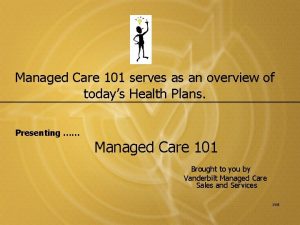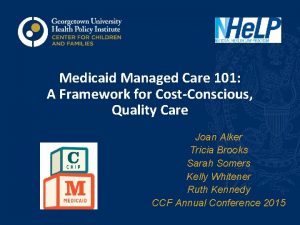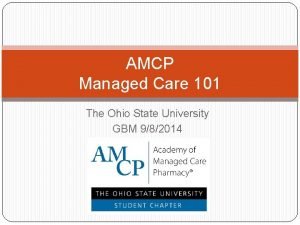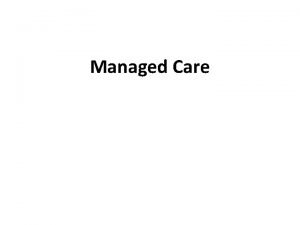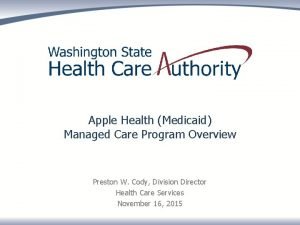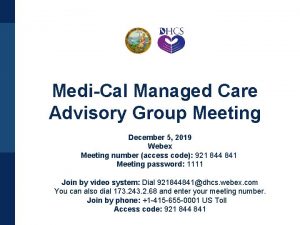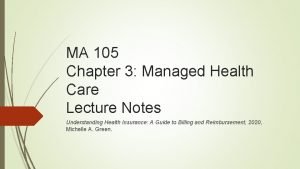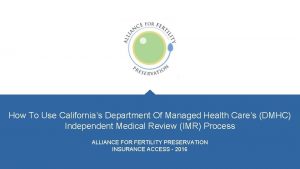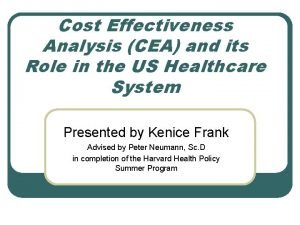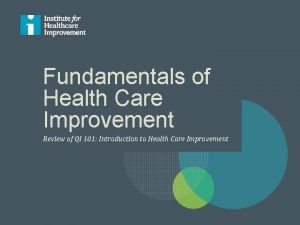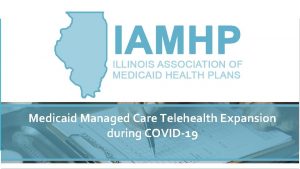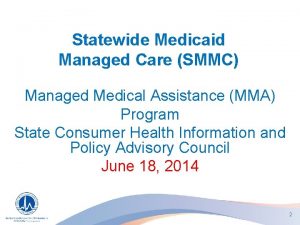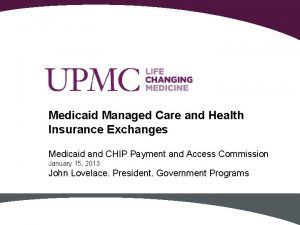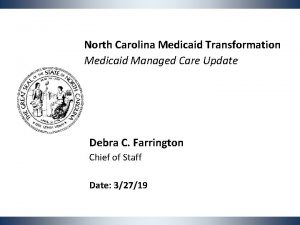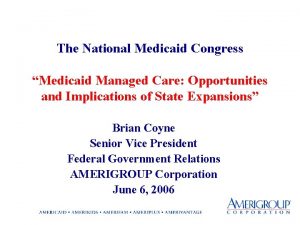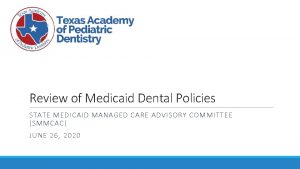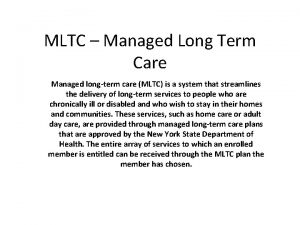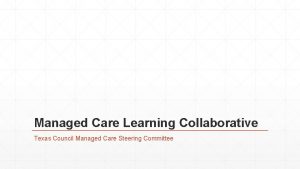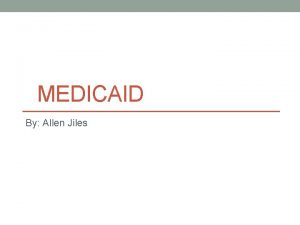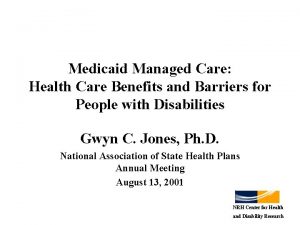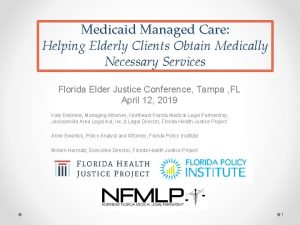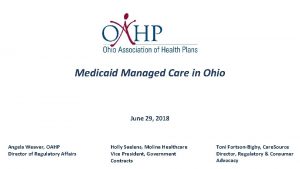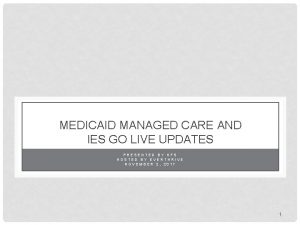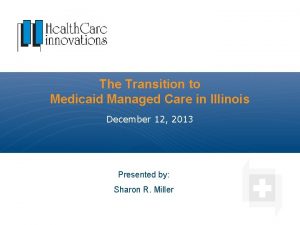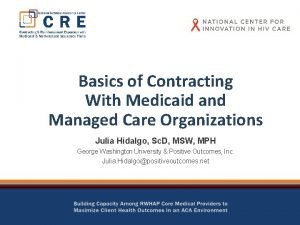Medicaid Managed Care 101 A Framework for CostConscious

































































- Slides: 65

Medicaid Managed Care 101: A Framework for Cost-Conscious, Quality Care Joan Alker Tricia Brooks Sarah Somers Kelly Whitener Ruth Kennedy CCF Annual Conference 2015

Today What we’ll talk about…. • • • Consumer Information Enrollment Disenrollment Plan choice Types of managed care Benefits and EPSDT Network adequacy Consumer protections Quality The State perspective What we’ll defer to MC 201…. • • Payment methodologies Actuarial soundness Rate setting Contract requirements

Approaching Our Work on Managed Care What do children and their families need? What do they need to know? How do we make sure that kids and families are well served?

POPULATIONS ENROLLMENT CONSUMER INFORMATION Tricia Brooks

Share of Medicaid Enrollees in Managed Care 74. 22% 71. 70% 63% 57. 58% 60% 50% 40% 29. 4% 30% 20% 14% 10% 3% 0% 1983 1984 1985 1986 1987 1988 1989 1990 1991 1992 1993 1994 1995 1996 1997 1998 1999 2000 2001 2002 2003 2004 2005 2006 2007 2008 2009 2010 2011 • Historically children and low income families • Recent shifting of duals and disabled to achieve better cost controls and care coordination for high need, high cost populations • All expansion adults 80%

Voluntary vs. Mandatory Voluntary enrollment can be offered to anyone in Medicaid Non-exempt groups can be mandated to enroll in managed care Waiver is required to enroll exempt populations Low voluntary enrollment can result in inadequate numbers of enrollees • • • Particularly true for high risk, high cost populations Issues can sometimes be addressed through welldesigned payment arrangements States more often move toward mandatory coverage 6

Populations State Plan Amendment • Children • Parents • Non-disabled Adults Need 1915(b) Waiver to Mandate Exempt Groups: • Children with special health care needs or disabilities • Children receiving foster care or adoption assistance • American Indians • Dual eligibles (poor elderly eligible for Medicare) 7

CONSUMER ISSUES THAT STATES MUST ADDRESS IN BUILDING DELIVERY SYSTEMS THAT INCLUDE MANAGED CARE 8

Choice Voluntary • Choice of FFS or voluntary enrollment in a managed care plan Mandatory • Risk-based managed care plans – Choice of plans • Exception for rural areas where choice of primary care provider is required • Other protections also exist • Primary care case management – Choice of providers 9

Plan Selection vs. Auto-Assignment • Goal for states is as to enroll as quickly as possible • Some states require that enrollees select a plan upfront when applying • Others wait until after eligibility has been determined • All must have auto-assignment (default enrollment) process for those who do not choose • Number of plans to choose from varies by state and region 10

Auto-Assignment (Default Enrollment) • Must preserve existing provider arrangements or relationships with providers that have traditionally served Medicaid • If not possible, must distribute “equitably” among plans • In practice, states assign based on a variety of NPRM would codify additional criteria to factors (e. g. , proximity to providers, enrollment of family members, and performance based measures) use in default enrollment, including quality 11

Other Enrollment Issues • No current enrollment provisions relating to voluntary managed care - Many states enroll directly and offer opt-out • No minimum period of time allowed for plan selection – Varies, by state, from a number of days to months – sometimes longer for disabled populations NPRM addresses both 12

Enrollment Brokers • States often contract with external enrollment brokers to provide choice counseling and conduct enrollment activities (438. 810(a)) • Must be independent from the managed care entities and free from conflict of interests • Mixed evidence of the effectiveness of enrollment brokers NPRM requires choice counseling and establishes broader requirement for beneficiary support system 13

Disenrollment Requested by Plan Requested by the Enrollee • May not disenroll based on utilization, change in health status, special needs • Contract should specify reasons plans may use for requesting disenrollment • First 90 days • At least once every 12 months, with 60 day notice • At any time for cause • May require enrollee to seek redress through grievance system before disenrolling • Effective no later than the first of the second month following the month of the request 14

Cause for Disenrollment • Enrollee moves out of service area • Plan does not cover service based on moral or religious objections • Enrollee needs related services to be performed at same time that are not available • Others, including but not limited to, poor quality, lack of access to covered services or qualified providers 15

Consumer Education • Health insurance literacy • Low-income uninsured may have little or no experience with managed care • May be transitioning from FFS to MC Net wo Getting He rk lp Enrollment es Drugs c i v r g Se Appe n s i t s i f s als Acce Bene 16

Notices and Written Information • All notices and informational or instructional materials must: - Be in an easily understood language and format - Be available in prevalent languages and alternative formats needed by those with special needs (e. g. limited vision, limited reading proficiency) - Inform enrollees and potential enrollees of the availability and how to access alternative formats • Provided upon eligibility determination in time to support plan selection 17

Language Support • States must… • Identify prevalent languages spoken by a significant number or percentage of enrollees and potential enrollees • State and plans must… • provide written information in all prevalent languages • provide oral interpretation for all non-English languages • must inform enrollees and potential enrollees of availability and how to access language supports 18

State Responsibilities • Mechanism to help enrollees and potential enrollees understand managed care • Must ensure that managed care plans fulfill their responsibilities • Information must include: – Basic features of managed care – Which groups are… • Able to enroll voluntarily • Excluded from enrollment • Required to enroll – Disenrollment rights 19

MC Plan Responsibilities • Mechanism to help enrollees and potential enrollees understand plan requirements and benefits NPRM has new and very detailed information requirements • Information must include: – Benefits and how to access – Cost-sharing – Service area – Provider information – Restrictions on choice of provider – When services of covered out of network – Grievances and appeals 20

Marketing Restrictions • Distribution of materials must be approved by state in consultation with Medical Care Advisory Committee • Must distribute to everyone in service area • Can’t sell other products • Info must not be fraudulent, misleading or confusing • Cold-calling is prohibited 21

Other Beneficiary Protections • Access to emergency services without prior authorization • Defines emergency medical conditions, services, and out-of-network access • No restrictions on patient-provider communications • Liability for payment • Anti-discrimination 22

Roll Out of New MC Implementation • No Standards but…. - Must be adequate time for system development - Sufficient resources to ensure smooth transition - Phased-in approach may work best 23

TYPES OF MANAGED CARE ENTITIES BENEFITS AND EPSDT NETWORK ADEQUACY AND ACCESS STANDARDS Sarah Somers 24

Medicaid Managed Care – Key Terms • Contract, RFP - Risk contract • Capitation - PMPM 25

Medicaid Managed Care Entities • MCO – Managed Care Organization • PIHP, PAHP – Prepaid Health Plan - (Inpatient or Ambulatory) • PCCM – Primary Care Case Management - “Managed’ fee for service • PACE – Program of all-inclusive care for the elderly 26

NPRM Adds New Definitions • PCCM Entity – Primary care case management entity • NEMT PAHP – Non-Emergency Transportation Prepaid Ambulatory Health Plan 27

Benefits • Basic requirement: - States must ensure that all services covered under Medicaid state plan are “available and accessible” 28

Adequacy of Services/Networks • MCOs/PHPs must: - Make covered services available to the same extent they are available to other beneficiaries Assure that they have adequate capacity to serve expected enrollment, including services and providers • PCCM contracts must provide for arrangements/referrals to sufficient numbers of providers to ensure prompt service delivery 29

Services for Enrollees with Special Health Care Needs • States must: - Identify such persons* to plans - Assess individual needs (using appropriate health care professionals) - Allow direct access to specialists • Require plans to produce a treatment plan (optional) - Developed by provider with enrollee input - Approved by plan *as defined by the state 30

Network Adequacy • No specific federal standards - Contracts - State law • Example: Virginia Contract (pp. 39, 245) • Example: California Regulations (28 Cal. Code. Regs. 1300. 67. 2) 31

32

33 33

34 34

Early and Periodic, Screening, Diagnosis and Treatment (EPSDT) • • • Required for beneficiaries under age 21 Outreach and informing “Screens” (check ups) Treatment Assistance with accessing services Great Resource 35

Policy Reasons for EPSDT Low-income children are more likely to have: ü ü ü ü ü Vision, hearing and speech problems Untreated tooth decay Elevated lead blood levels Sickle cell disease Behavioral Health problems Anemia Asthma Transportation barriers And more. . . 36

EPSDT Requirements: Mandatory Screenings Medical Screens Other Screens ü Health and developmental history ü Unclothed physical exam ü Immunizations ü Lab tests, including lead blood tests ü Health education ü Vision, including eyeglasses ü Hearing, including hearing aids ü Dental, including relief of pain, restoration of teeth and maintenance of dental health 37

EPSDT Requirements: Treatment • All services that could be covered under state Medicaid plan (mandatory and optional) • All Medicaid-covered services necessary to “correct or ameliorate physical and mental illnesses and conditions, ” even if the service is not covered under the state plan • CMS Guidance: no hard limits on hours/visits 38

EPSDT Requirements: Outreach and Informing • Effective and aggressive - Oral and written - Translated - Targeted (e. g. pregnant teens, non-users) • Transportation and appointment assistance (prior to screen due date) • Coordination with other entities 39

EPSDT: Issues in Managed Care • Non-coverage of services - Carve outs, failure of state to ensure services are provided • Limits on number of visits/hours • Prior authorization for screens, delaying services • Stricter medical necessity definition than state uses 40

Questions? 41

GRIEVANCES AND APPEALS Sarah Somers 42

Medicaid Due Process: Legal Authority • • • Constitution Medicaid statute Federal regulations State law Contracts (MC) 43

What triggers right to hearing? • Denial of application for benefits/failure to act with reasonable promptness • Agency has taken an action erroneously • Reduction, suspension, termination of service • PASRR, transfer or discharge from NF 44

Right to Appeal, cont’d • “Action” of MCO: - Denying, reducing, terminating or otherwise limiting services or denying payment for services - Failing to timely provide services - Denying request for disenrollment or exemption - “otherwise adversely affecting the individual” 45

Notice • Must include: - Action taken Reasons for action Right to file appeal Right file state hearing request Expedited resolution Continued benefits 46

Grievance • An expression of dissatisfaction about any matter other than an action 47

Continued Benefits • Must continue pending final hearing decision if hearing is requested w/in 10 days of action - When MCO appeal taken and beneficiary loses, must again request services continue pending fair hearing decision - Beneficiary can be required to pay for benefits if he ultimately loses • ISSUE – no continued benefits beyond authorization period 48

QUALITY MEASUREMENT AND IMPROVEMENT Tricia Brooks 49

Quality Assessment and Improvement Strategy • Current regulations focus quality measurement and improvement strategies on MCO’s and PIHP’s. NPRM expands quality requirements to all delivery systems, including FFS and all types of MC entities 50

Each State Contracting with an MCO or PIHP must…. • Have a written strategy for assessing and improving quality • Obtain public input • Ensure plan compliance • Review effectiveness and update the strategy • Submit strategy to CMS, as well as updates and reports on implementation and effectiveness 51

Required Elements of Quality Strategy • Assess the quality and appropriateness of care to everyone, and to those with special health needs • Identify and provide to plans at enrollment, the race, ethnicity, and primary language of each enrollee • Monitor and evaluate plan compliance • Incorporate national performance measures if applicable • Arrange for annual independent external quality review (EQR) • Ensures adoption and dissemination of practice guidelines 52

MC Entity Must Conduct Performance Improvement Projects Use objective measurements Assess clinical and nonclinical areas Implement system interventions to improve care Evaluate effectiveness Submit state or CMS specified performance measurement data • Identify both underutilization and overutilization of services • Assess quality and appropriateness of care for enrollees with SHCN • • • 53

External Quality Review (EQR) • Applies to MCO, PHIP, HIO • EQR organization must meet federal standards • Analyzes and evaluates aggregated information on quality, timeliness, and access to health care services • Reports must be submitted to CMS but vary across states in organization and level of detail due to differing interpretation of the regulations http: //www. healthlaw. org/issues/medicaid/managed-care/EQROverview 06162014 pdf#. VQ 7 Jv. BDF_2 w 54

EQR? Validates performance measures and improvement programs : Mandatory EQR Activities Optional EQR Activities - Evaluate quality, timeliness, and access to care - Assess plan’s strengths and weaknesses, and recommend quality improvement project - Appraise how well each plan responded to previous QI recommendations - Validate encounter level data - Administer or validate consumer or provider surveys - Calculate state-required performance measures - Conduct detailed PIP reviews - Conduct focused, one-time studies NPRM adds network adequacy validation to mandatory activities 55

Common Issues Across EQR Reports • Data collection methods vary • No federally required measures; states can pick and choose but tend to use most common • Challenging to compare across states or plans • MCO’s come and go, so difficult to form a picture of system performance • Comprehensiveness of the reporting to CMS is improving NPRM lays foundation for alignment and more consistent reporting on quality 56

CHIP Kelly Whitener 57

CHIP Managed Care Rules • The Children’s Health Insurance Program Reauthorization Act of 2009 (CHIPRA) applied several Medicaid managed care provisions to CHIP at section 2103(f)(3) of the Social Security Act: - Section 1932(a)(4): Process for enrollment and termination and change of enrollment - Section 1932(a)(5): Provision of information - Section 1932(b): Beneficiary protections - Section 1932(c): Quality assurance standards - Section 1932(d): Protections against fraud and abuse - Section 1932(e): Sanction for noncompliance 58

CHIP Managed Care Rules • CMS provided initial guidance on these rules in two State Health Official (SHO) letters - SHO#09 -008 offered guidance on implementing the new requirements generally, including submitting CHIP managed care contracts to CMS for review for the first time - SHO#09 -013 offered additional guidance on the quality provisions in particular - Both letters indicated more information was forthcoming, and it arrived on June 1 this year, proposing managed care regulations in CHIP for the first time! 59

How is CHIP managed care different? Contracts & Rates Beneficiary Enrollment • Contracts are typically not reviewed by CMS, and they do not have to be approved prior to implementation • Capitation rates are not reviewed by CMS and they do not have to meet actuarial soundness requirements • There is no requirement for beneficiaries to have a choice of plans at enrollment, but must have another option if they choose to disenroll from the managed care plan • Beneficiaries can be required to pay premiums prior to enrollment 60

THE STATE PERSPECTIVE Ruth Kennedy 61

QUESTIONS AND DISCUSSION 62

Resources • CMS “Medicaid Managed Care Enrollment Report, ” July 2011 http: //www. medicaid. gov/Medicaid-CHIP-Program-Information/By-Topics/Dataand-Systems/Downloads/2011 -Medicaid-MC-Enrollment-Report. pdf • CMS Medicaid Managed Care Web Pages http: //www. medicaid. gov/medicaid-chip-program-information/by-topics/deliverysystems/managed-care-site. html • MACPAC “The Evolution of Managed Care in Medicaid, ” June 2011 http: //www. mhpa. org/_upload/MACPAC_June 2011_web. pdf • Kaiser Family Foundation “A Profile of Medicaid Managed Care Programs in 2010: Findings from a 50 -State Survey” http: //kff. org/medicaid/report/a-profile-of-medicaid-managed-care-programs-in 2010 -findings-from-a-50 -state-survey/ • Kaiser Family Foundation “Medicaid Managed Care Tracker” http: //kff. org/data-collection/medicaid-managed-care-market-tracker/

NHe. LP Resources • “A Guide to Oversight, Transparency, and Accountability in Medicaid Managed Care” http: //www. healthlaw. org/publications/browse -all-publications/managed-care-toolkit-march-2015#. Va. MGs 5 NViko • “Survey of Medicaid Managed Care Contracts: EPSDT Vision and Hearing Services” http: //www. healthlaw. org/publications/searchpublications/managed-care-survey-EPSDT • Model Provisions: #1 Grievances and Appeals; #2 Enrollment and Disenrollment; #3 Network Adequacy; #4 Accessibility & Language Access; #5 Reproductive Health http: //www. healthlaw. org/publications/search-publications • Network Adequacy in Medicaid Managed Care: Recommendations for Advocates http: //www. healthlaw. org/publications/search-publications/network-adequacy-in -medicaid-managed-care#. Va. MJd. JNViko 64

Contact Sarah Somers somers@healthlaw. org www. healthlaw. org Joan Alker jca 25@georgetown. edu Tricia Brooks pab 62@georgetown. edu Kelly Whitener kdw 29@georgetown. edu 65
 Managed care 101
Managed care 101 Managed care 101
Managed care 101 Osu amcp
Osu amcp Ppo managed care
Ppo managed care Care continuum prior authorization
Care continuum prior authorization Mhc fully integrated managed care
Mhc fully integrated managed care Michelle retke
Michelle retke Managed care is categorized according to six models
Managed care is categorized according to six models History of managed care
History of managed care Vp managed care
Vp managed care Department of managed health care california
Department of managed health care california Cea registry
Cea registry Primary secondary tertiary health care definition
Primary secondary tertiary health care definition Ihi leadership alliance
Ihi leadership alliance Health care 101
Health care 101 Qi 101: introduction to health care improvement
Qi 101: introduction to health care improvement Kontinuitetshantering i praktiken
Kontinuitetshantering i praktiken Novell typiska drag
Novell typiska drag Nationell inriktning för artificiell intelligens
Nationell inriktning för artificiell intelligens Vad står k.r.å.k.a.n för
Vad står k.r.å.k.a.n för Varför kallas perioden 1918-1939 för mellankrigstiden?
Varför kallas perioden 1918-1939 för mellankrigstiden? En lathund för arbete med kontinuitetshantering
En lathund för arbete med kontinuitetshantering Personalliggare bygg undantag
Personalliggare bygg undantag Tidbok för yrkesförare
Tidbok för yrkesförare A gastrica
A gastrica Förklara densitet för barn
Förklara densitet för barn Datorkunskap för nybörjare
Datorkunskap för nybörjare Tack för att ni lyssnade bild
Tack för att ni lyssnade bild Debattartikel struktur
Debattartikel struktur Delegerande ledarstil
Delegerande ledarstil Nyckelkompetenser för livslångt lärande
Nyckelkompetenser för livslångt lärande Påbyggnader för flakfordon
Påbyggnader för flakfordon Kraft per area
Kraft per area Publik sektor
Publik sektor Bo bergman jag fryser om dina händer
Bo bergman jag fryser om dina händer Presentera för publik crossboss
Presentera för publik crossboss Teckenspråk minoritetsspråk argument
Teckenspråk minoritetsspråk argument Kanaans land
Kanaans land Treserva lathund
Treserva lathund Luftstrupen för medicinare
Luftstrupen för medicinare Claes martinsson
Claes martinsson Centrum för kunskap och säkerhet
Centrum för kunskap och säkerhet Verifikationsplan
Verifikationsplan Mat för idrottare
Mat för idrottare Verktyg för automatisering av utbetalningar
Verktyg för automatisering av utbetalningar Rutin för avvikelsehantering
Rutin för avvikelsehantering Smärtskolan kunskap för livet
Smärtskolan kunskap för livet Ministerstyre för och nackdelar
Ministerstyre för och nackdelar Tack för att ni har lyssnat
Tack för att ni har lyssnat Vad är referatmarkeringar
Vad är referatmarkeringar Redogör för vad psykologi är
Redogör för vad psykologi är Stål för stötfångarsystem
Stål för stötfångarsystem Tack för att ni har lyssnat
Tack för att ni har lyssnat Borra hål för knoppar
Borra hål för knoppar Vilken grundregel finns det för tronföljden i sverige?
Vilken grundregel finns det för tronföljden i sverige? Standardavvikelse
Standardavvikelse Tack för att ni har lyssnat
Tack för att ni har lyssnat Rita perspektiv
Rita perspektiv Verksamhetsanalys exempel
Verksamhetsanalys exempel Tobinskatten för och nackdelar
Tobinskatten för och nackdelar Toppslätskivling effekt
Toppslätskivling effekt Mästar lärling modellen
Mästar lärling modellen Egg för emanuel
Egg för emanuel Elektronik för barn
Elektronik för barn Klädsel i rom
Klädsel i rom Strategi för svensk viltförvaltning
Strategi för svensk viltförvaltning
